Essay: Organizational Diversity and Management in the 21st Century
VerifiedAdded on 2022/09/23
|12
|4227
|27
Essay
AI Summary
This essay provides a comprehensive analysis of organizational diversity and its implications for 21st-century management. It examines various perspectives, including historical, sociological, rational technical, political, psychological, cultural, and symbolic, to understand how organizations function and adapt to the changing environment. The essay discusses the evolution of management theories, from traditional approaches to contemporary models, and highlights the importance of leadership, technological advancements, and employee empowerment. It explores the challenges and opportunities faced by organizations in the modern era, emphasizing the need for flexibility, transparency, and a focus on employee development and satisfaction. The essay also delves into key concepts such as bureaucratic management, human relations, and the impact of social networks and knowledge-sharing on organizational success. Overall, the essay offers valuable insights into the complexities of organizational diversity and its significance in shaping the future of management practices.
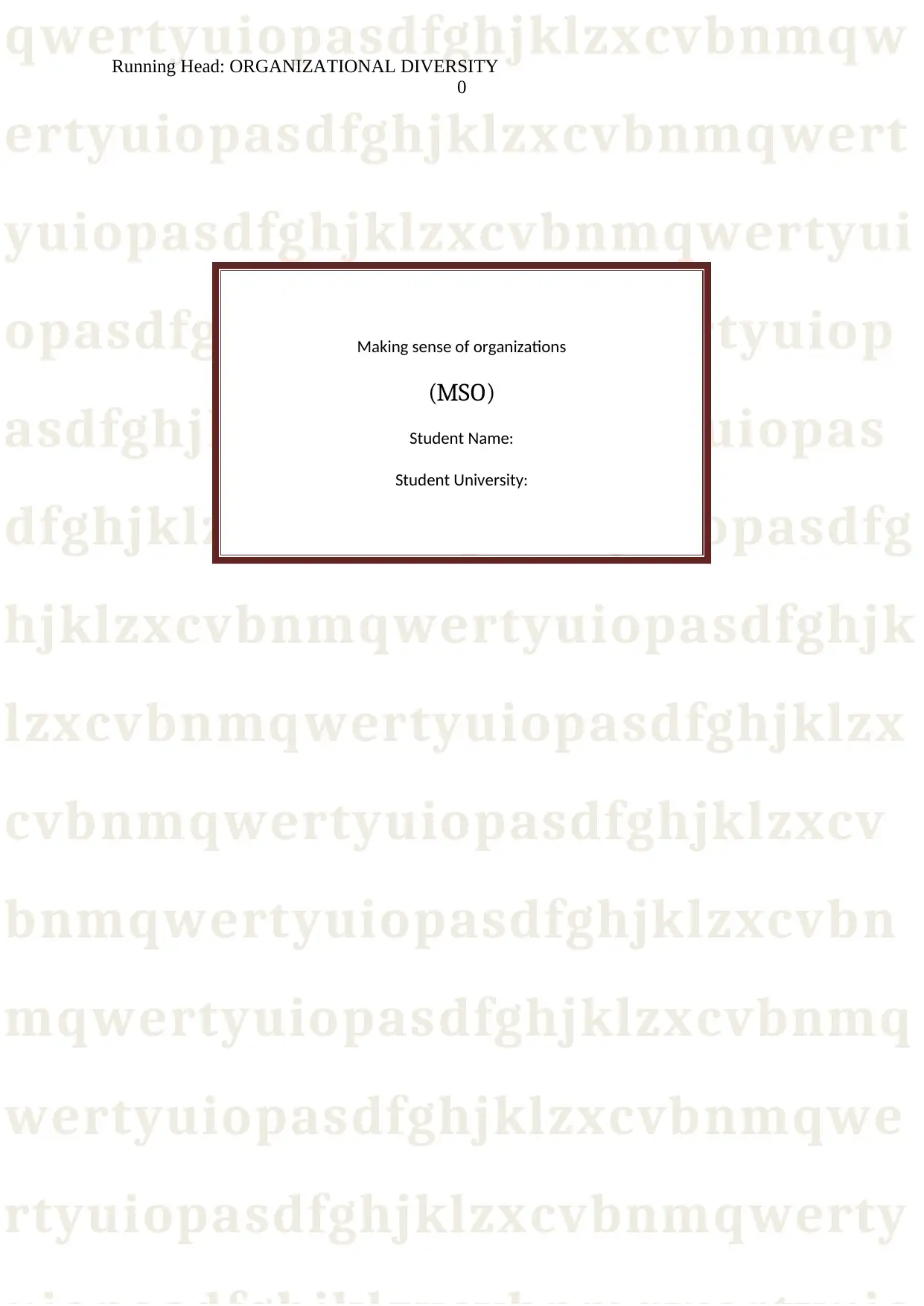
qwertyuiopasdfghjklzxcvbnmqw
ertyuiopasdfghjklzxcvbnmqwert
yuiopasdfghjklzxcvbnmqwertyui
opasdfghjklzxcvbnmqwertyuiop
asdfghjklzxcvbnmqwertyuiopas
dfghjklzxcvbnmqwertyuiopasdfg
hjklzxcvbnmqwertyuiopasdfghjk
lzxcvbnmqwertyuiopasdfghjklzx
cvbnmqwertyuiopasdfghjklzxcv
bnmqwertyuiopasdfghjklzxcvbn
mqwertyuiopasdfghjklzxcvbnmq
wertyuiopasdfghjklzxcvbnmqwe
rtyuiopasdfghjklzxcvbnmqwerty
Running Head: ORGANIZATIONAL DIVERSITY
0
Making sense of organizations
(MSO)
Student Name:
Student University:
ertyuiopasdfghjklzxcvbnmqwert
yuiopasdfghjklzxcvbnmqwertyui
opasdfghjklzxcvbnmqwertyuiop
asdfghjklzxcvbnmqwertyuiopas
dfghjklzxcvbnmqwertyuiopasdfg
hjklzxcvbnmqwertyuiopasdfghjk
lzxcvbnmqwertyuiopasdfghjklzx
cvbnmqwertyuiopasdfghjklzxcv
bnmqwertyuiopasdfghjklzxcvbn
mqwertyuiopasdfghjklzxcvbnmq
wertyuiopasdfghjklzxcvbnmqwe
rtyuiopasdfghjklzxcvbnmqwerty
Running Head: ORGANIZATIONAL DIVERSITY
0
Making sense of organizations
(MSO)
Student Name:
Student University:
Paraphrase This Document
Need a fresh take? Get an instant paraphrase of this document with our AI Paraphraser
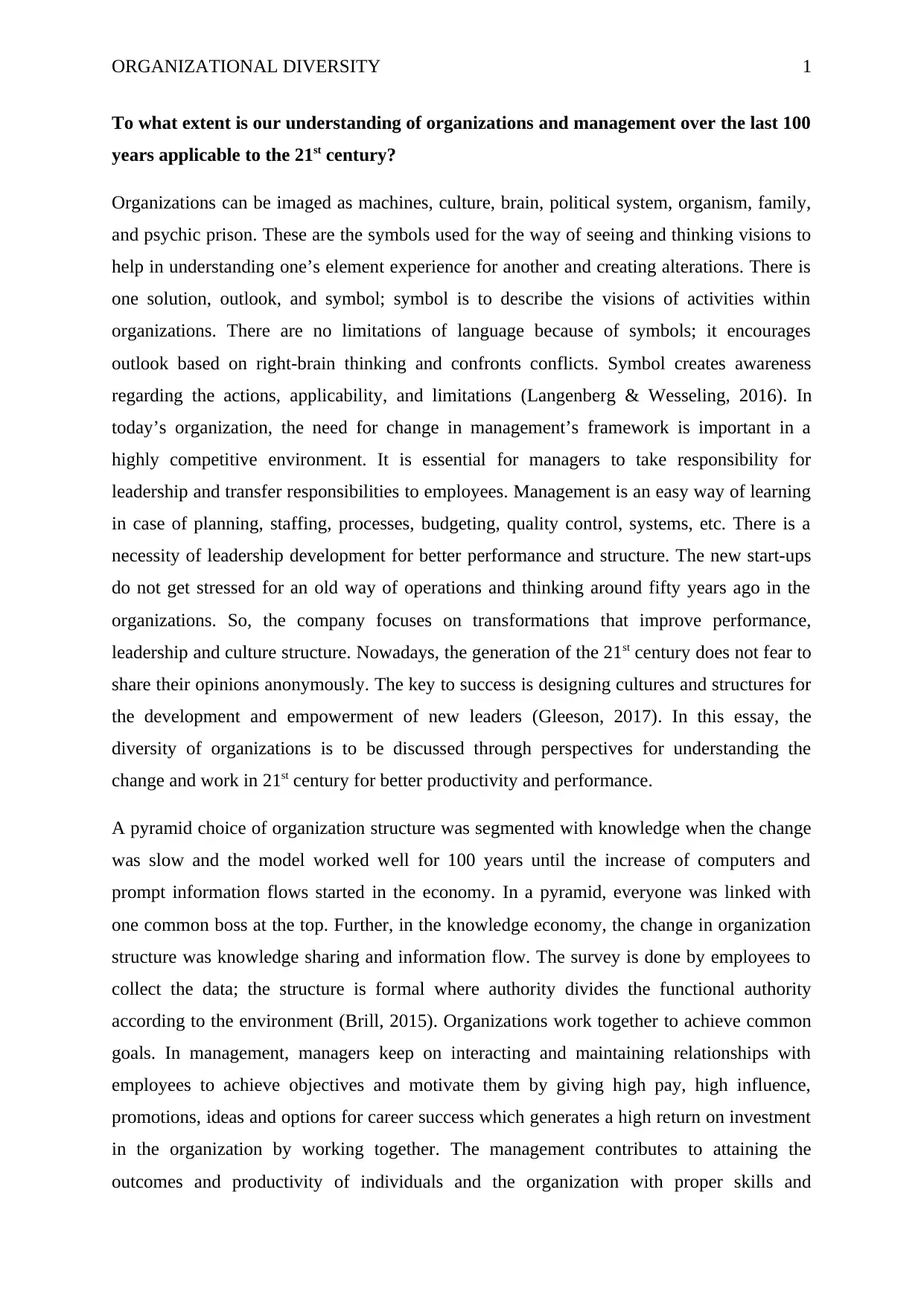
ORGANIZATIONAL DIVERSITY 1
To what extent is our understanding of organizations and management over the last 100
years applicable to the 21st century?
Organizations can be imaged as machines, culture, brain, political system, organism, family,
and psychic prison. These are the symbols used for the way of seeing and thinking visions to
help in understanding one’s element experience for another and creating alterations. There is
one solution, outlook, and symbol; symbol is to describe the visions of activities within
organizations. There are no limitations of language because of symbols; it encourages
outlook based on right-brain thinking and confronts conflicts. Symbol creates awareness
regarding the actions, applicability, and limitations (Langenberg & Wesseling, 2016). In
today’s organization, the need for change in management’s framework is important in a
highly competitive environment. It is essential for managers to take responsibility for
leadership and transfer responsibilities to employees. Management is an easy way of learning
in case of planning, staffing, processes, budgeting, quality control, systems, etc. There is a
necessity of leadership development for better performance and structure. The new start-ups
do not get stressed for an old way of operations and thinking around fifty years ago in the
organizations. So, the company focuses on transformations that improve performance,
leadership and culture structure. Nowadays, the generation of the 21st century does not fear to
share their opinions anonymously. The key to success is designing cultures and structures for
the development and empowerment of new leaders (Gleeson, 2017). In this essay, the
diversity of organizations is to be discussed through perspectives for understanding the
change and work in 21st century for better productivity and performance.
A pyramid choice of organization structure was segmented with knowledge when the change
was slow and the model worked well for 100 years until the increase of computers and
prompt information flows started in the economy. In a pyramid, everyone was linked with
one common boss at the top. Further, in the knowledge economy, the change in organization
structure was knowledge sharing and information flow. The survey is done by employees to
collect the data; the structure is formal where authority divides the functional authority
according to the environment (Brill, 2015). Organizations work together to achieve common
goals. In management, managers keep on interacting and maintaining relationships with
employees to achieve objectives and motivate them by giving high pay, high influence,
promotions, ideas and options for career success which generates a high return on investment
in the organization by working together. The management contributes to attaining the
outcomes and productivity of individuals and the organization with proper skills and
To what extent is our understanding of organizations and management over the last 100
years applicable to the 21st century?
Organizations can be imaged as machines, culture, brain, political system, organism, family,
and psychic prison. These are the symbols used for the way of seeing and thinking visions to
help in understanding one’s element experience for another and creating alterations. There is
one solution, outlook, and symbol; symbol is to describe the visions of activities within
organizations. There are no limitations of language because of symbols; it encourages
outlook based on right-brain thinking and confronts conflicts. Symbol creates awareness
regarding the actions, applicability, and limitations (Langenberg & Wesseling, 2016). In
today’s organization, the need for change in management’s framework is important in a
highly competitive environment. It is essential for managers to take responsibility for
leadership and transfer responsibilities to employees. Management is an easy way of learning
in case of planning, staffing, processes, budgeting, quality control, systems, etc. There is a
necessity of leadership development for better performance and structure. The new start-ups
do not get stressed for an old way of operations and thinking around fifty years ago in the
organizations. So, the company focuses on transformations that improve performance,
leadership and culture structure. Nowadays, the generation of the 21st century does not fear to
share their opinions anonymously. The key to success is designing cultures and structures for
the development and empowerment of new leaders (Gleeson, 2017). In this essay, the
diversity of organizations is to be discussed through perspectives for understanding the
change and work in 21st century for better productivity and performance.
A pyramid choice of organization structure was segmented with knowledge when the change
was slow and the model worked well for 100 years until the increase of computers and
prompt information flows started in the economy. In a pyramid, everyone was linked with
one common boss at the top. Further, in the knowledge economy, the change in organization
structure was knowledge sharing and information flow. The survey is done by employees to
collect the data; the structure is formal where authority divides the functional authority
according to the environment (Brill, 2015). Organizations work together to achieve common
goals. In management, managers keep on interacting and maintaining relationships with
employees to achieve objectives and motivate them by giving high pay, high influence,
promotions, ideas and options for career success which generates a high return on investment
in the organization by working together. The management contributes to attaining the
outcomes and productivity of individuals and the organization with proper skills and
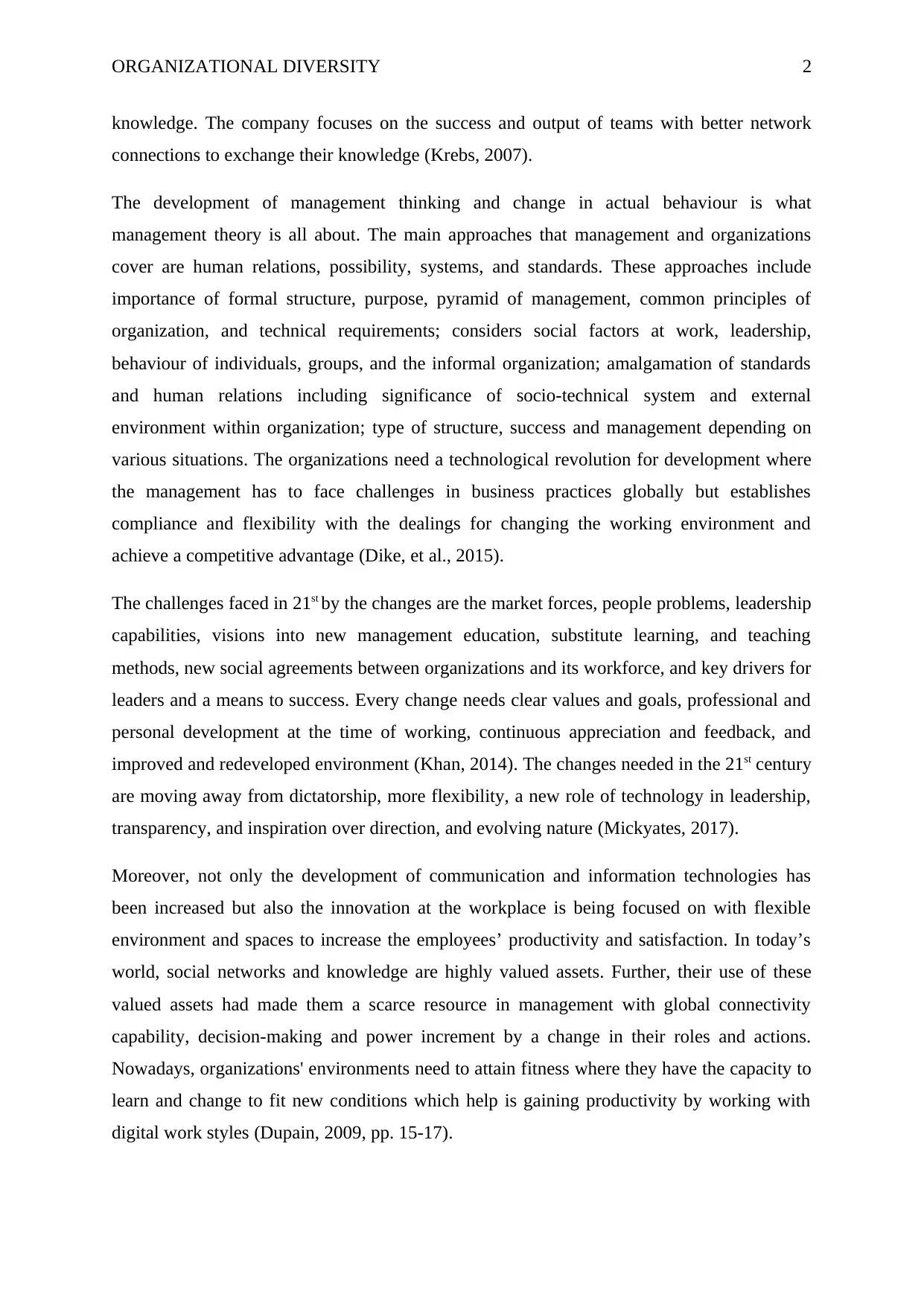
ORGANIZATIONAL DIVERSITY 2
knowledge. The company focuses on the success and output of teams with better network
connections to exchange their knowledge (Krebs, 2007).
The development of management thinking and change in actual behaviour is what
management theory is all about. The main approaches that management and organizations
cover are human relations, possibility, systems, and standards. These approaches include
importance of formal structure, purpose, pyramid of management, common principles of
organization, and technical requirements; considers social factors at work, leadership,
behaviour of individuals, groups, and the informal organization; amalgamation of standards
and human relations including significance of socio-technical system and external
environment within organization; type of structure, success and management depending on
various situations. The organizations need a technological revolution for development where
the management has to face challenges in business practices globally but establishes
compliance and flexibility with the dealings for changing the working environment and
achieve a competitive advantage (Dike, et al., 2015).
The challenges faced in 21st by the changes are the market forces, people problems, leadership
capabilities, visions into new management education, substitute learning, and teaching
methods, new social agreements between organizations and its workforce, and key drivers for
leaders and a means to success. Every change needs clear values and goals, professional and
personal development at the time of working, continuous appreciation and feedback, and
improved and redeveloped environment (Khan, 2014). The changes needed in the 21st century
are moving away from dictatorship, more flexibility, a new role of technology in leadership,
transparency, and inspiration over direction, and evolving nature (Mickyates, 2017).
Moreover, not only the development of communication and information technologies has
been increased but also the innovation at the workplace is being focused on with flexible
environment and spaces to increase the employees’ productivity and satisfaction. In today’s
world, social networks and knowledge are highly valued assets. Further, their use of these
valued assets had made them a scarce resource in management with global connectivity
capability, decision-making and power increment by a change in their roles and actions.
Nowadays, organizations' environments need to attain fitness where they have the capacity to
learn and change to fit new conditions which help is gaining productivity by working with
digital work styles (Dupain, 2009, pp. 15-17).
knowledge. The company focuses on the success and output of teams with better network
connections to exchange their knowledge (Krebs, 2007).
The development of management thinking and change in actual behaviour is what
management theory is all about. The main approaches that management and organizations
cover are human relations, possibility, systems, and standards. These approaches include
importance of formal structure, purpose, pyramid of management, common principles of
organization, and technical requirements; considers social factors at work, leadership,
behaviour of individuals, groups, and the informal organization; amalgamation of standards
and human relations including significance of socio-technical system and external
environment within organization; type of structure, success and management depending on
various situations. The organizations need a technological revolution for development where
the management has to face challenges in business practices globally but establishes
compliance and flexibility with the dealings for changing the working environment and
achieve a competitive advantage (Dike, et al., 2015).
The challenges faced in 21st by the changes are the market forces, people problems, leadership
capabilities, visions into new management education, substitute learning, and teaching
methods, new social agreements between organizations and its workforce, and key drivers for
leaders and a means to success. Every change needs clear values and goals, professional and
personal development at the time of working, continuous appreciation and feedback, and
improved and redeveloped environment (Khan, 2014). The changes needed in the 21st century
are moving away from dictatorship, more flexibility, a new role of technology in leadership,
transparency, and inspiration over direction, and evolving nature (Mickyates, 2017).
Moreover, not only the development of communication and information technologies has
been increased but also the innovation at the workplace is being focused on with flexible
environment and spaces to increase the employees’ productivity and satisfaction. In today’s
world, social networks and knowledge are highly valued assets. Further, their use of these
valued assets had made them a scarce resource in management with global connectivity
capability, decision-making and power increment by a change in their roles and actions.
Nowadays, organizations' environments need to attain fitness where they have the capacity to
learn and change to fit new conditions which help is gaining productivity by working with
digital work styles (Dupain, 2009, pp. 15-17).
⊘ This is a preview!⊘
Do you want full access?
Subscribe today to unlock all pages.

Trusted by 1+ million students worldwide
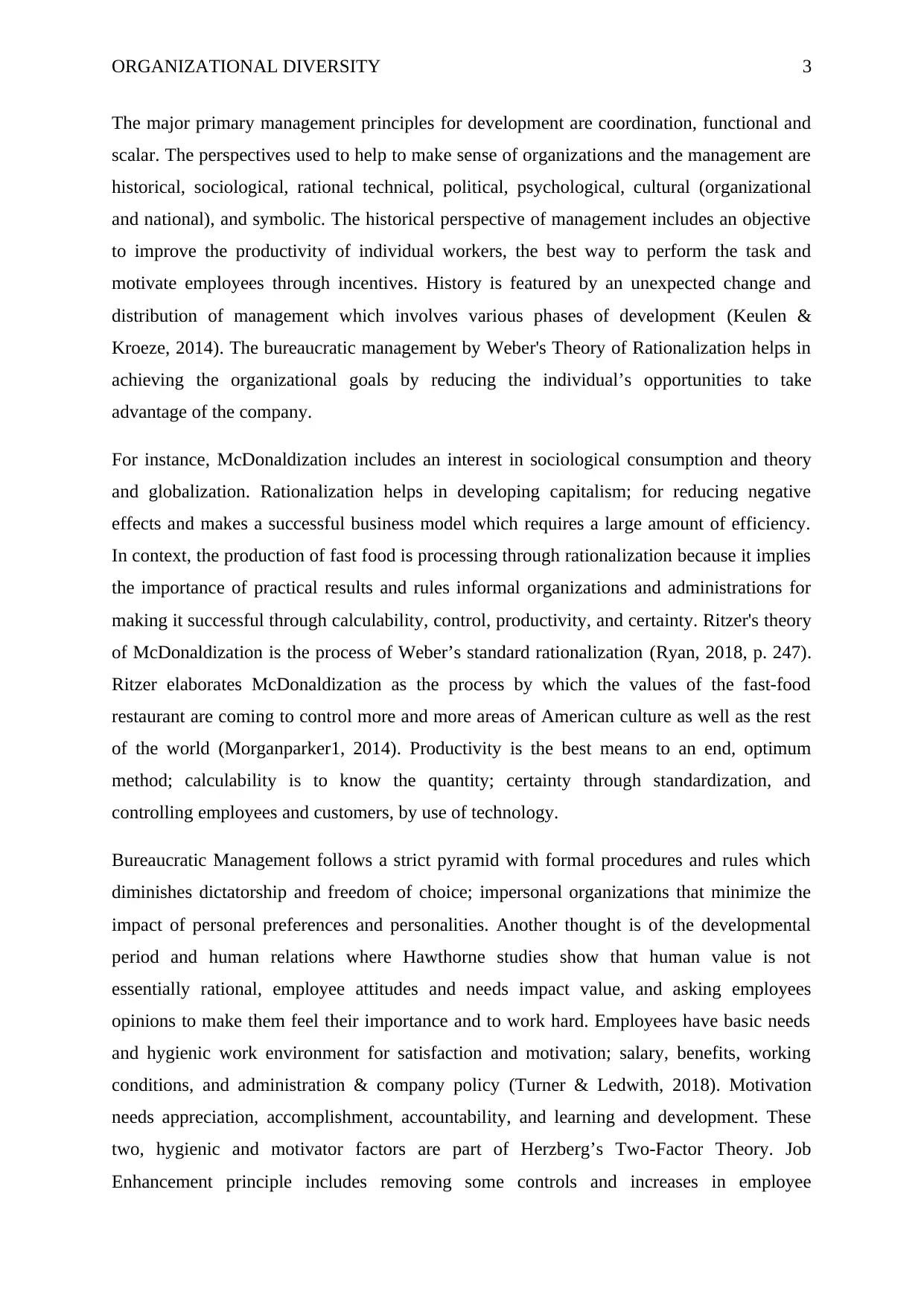
ORGANIZATIONAL DIVERSITY 3
The major primary management principles for development are coordination, functional and
scalar. The perspectives used to help to make sense of organizations and the management are
historical, sociological, rational technical, political, psychological, cultural (organizational
and national), and symbolic. The historical perspective of management includes an objective
to improve the productivity of individual workers, the best way to perform the task and
motivate employees through incentives. History is featured by an unexpected change and
distribution of management which involves various phases of development (Keulen &
Kroeze, 2014). The bureaucratic management by Weber's Theory of Rationalization helps in
achieving the organizational goals by reducing the individual’s opportunities to take
advantage of the company.
For instance, McDonaldization includes an interest in sociological consumption and theory
and globalization. Rationalization helps in developing capitalism; for reducing negative
effects and makes a successful business model which requires a large amount of efficiency.
In context, the production of fast food is processing through rationalization because it implies
the importance of practical results and rules informal organizations and administrations for
making it successful through calculability, control, productivity, and certainty. Ritzer's theory
of McDonaldization is the process of Weber’s standard rationalization (Ryan, 2018, p. 247).
Ritzer elaborates McDonaldization as the process by which the values of the fast-food
restaurant are coming to control more and more areas of American culture as well as the rest
of the world (Morganparker1, 2014). Productivity is the best means to an end, optimum
method; calculability is to know the quantity; certainty through standardization, and
controlling employees and customers, by use of technology.
Bureaucratic Management follows a strict pyramid with formal procedures and rules which
diminishes dictatorship and freedom of choice; impersonal organizations that minimize the
impact of personal preferences and personalities. Another thought is of the developmental
period and human relations where Hawthorne studies show that human value is not
essentially rational, employee attitudes and needs impact value, and asking employees
opinions to make them feel their importance and to work hard. Employees have basic needs
and hygienic work environment for satisfaction and motivation; salary, benefits, working
conditions, and administration & company policy (Turner & Ledwith, 2018). Motivation
needs appreciation, accomplishment, accountability, and learning and development. These
two, hygienic and motivator factors are part of Herzberg’s Two-Factor Theory. Job
Enhancement principle includes removing some controls and increases in employee
The major primary management principles for development are coordination, functional and
scalar. The perspectives used to help to make sense of organizations and the management are
historical, sociological, rational technical, political, psychological, cultural (organizational
and national), and symbolic. The historical perspective of management includes an objective
to improve the productivity of individual workers, the best way to perform the task and
motivate employees through incentives. History is featured by an unexpected change and
distribution of management which involves various phases of development (Keulen &
Kroeze, 2014). The bureaucratic management by Weber's Theory of Rationalization helps in
achieving the organizational goals by reducing the individual’s opportunities to take
advantage of the company.
For instance, McDonaldization includes an interest in sociological consumption and theory
and globalization. Rationalization helps in developing capitalism; for reducing negative
effects and makes a successful business model which requires a large amount of efficiency.
In context, the production of fast food is processing through rationalization because it implies
the importance of practical results and rules informal organizations and administrations for
making it successful through calculability, control, productivity, and certainty. Ritzer's theory
of McDonaldization is the process of Weber’s standard rationalization (Ryan, 2018, p. 247).
Ritzer elaborates McDonaldization as the process by which the values of the fast-food
restaurant are coming to control more and more areas of American culture as well as the rest
of the world (Morganparker1, 2014). Productivity is the best means to an end, optimum
method; calculability is to know the quantity; certainty through standardization, and
controlling employees and customers, by use of technology.
Bureaucratic Management follows a strict pyramid with formal procedures and rules which
diminishes dictatorship and freedom of choice; impersonal organizations that minimize the
impact of personal preferences and personalities. Another thought is of the developmental
period and human relations where Hawthorne studies show that human value is not
essentially rational, employee attitudes and needs impact value, and asking employees
opinions to make them feel their importance and to work hard. Employees have basic needs
and hygienic work environment for satisfaction and motivation; salary, benefits, working
conditions, and administration & company policy (Turner & Ledwith, 2018). Motivation
needs appreciation, accomplishment, accountability, and learning and development. These
two, hygienic and motivator factors are part of Herzberg’s Two-Factor Theory. Job
Enhancement principle includes removing some controls and increases in employee
Paraphrase This Document
Need a fresh take? Get an instant paraphrase of this document with our AI Paraphraser
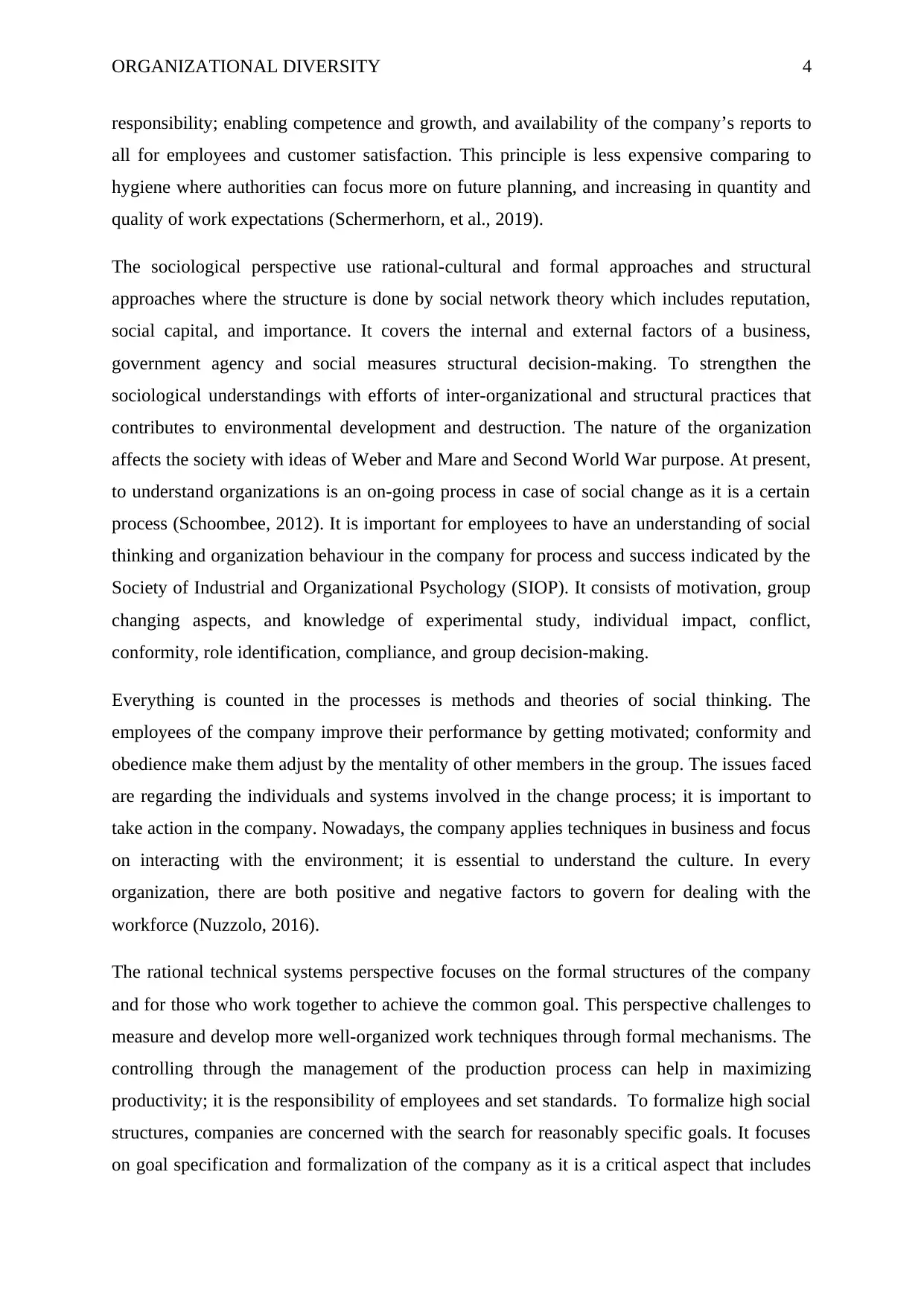
ORGANIZATIONAL DIVERSITY 4
responsibility; enabling competence and growth, and availability of the company’s reports to
all for employees and customer satisfaction. This principle is less expensive comparing to
hygiene where authorities can focus more on future planning, and increasing in quantity and
quality of work expectations (Schermerhorn, et al., 2019).
The sociological perspective use rational-cultural and formal approaches and structural
approaches where the structure is done by social network theory which includes reputation,
social capital, and importance. It covers the internal and external factors of a business,
government agency and social measures structural decision-making. To strengthen the
sociological understandings with efforts of inter-organizational and structural practices that
contributes to environmental development and destruction. The nature of the organization
affects the society with ideas of Weber and Mare and Second World War purpose. At present,
to understand organizations is an on-going process in case of social change as it is a certain
process (Schoombee, 2012). It is important for employees to have an understanding of social
thinking and organization behaviour in the company for process and success indicated by the
Society of Industrial and Organizational Psychology (SIOP). It consists of motivation, group
changing aspects, and knowledge of experimental study, individual impact, conflict,
conformity, role identification, compliance, and group decision-making.
Everything is counted in the processes is methods and theories of social thinking. The
employees of the company improve their performance by getting motivated; conformity and
obedience make them adjust by the mentality of other members in the group. The issues faced
are regarding the individuals and systems involved in the change process; it is important to
take action in the company. Nowadays, the company applies techniques in business and focus
on interacting with the environment; it is essential to understand the culture. In every
organization, there are both positive and negative factors to govern for dealing with the
workforce (Nuzzolo, 2016).
The rational technical systems perspective focuses on the formal structures of the company
and for those who work together to achieve the common goal. This perspective challenges to
measure and develop more well-organized work techniques through formal mechanisms. The
controlling through the management of the production process can help in maximizing
productivity; it is the responsibility of employees and set standards. To formalize high social
structures, companies are concerned with the search for reasonably specific goals. It focuses
on goal specification and formalization of the company as it is a critical aspect that includes
responsibility; enabling competence and growth, and availability of the company’s reports to
all for employees and customer satisfaction. This principle is less expensive comparing to
hygiene where authorities can focus more on future planning, and increasing in quantity and
quality of work expectations (Schermerhorn, et al., 2019).
The sociological perspective use rational-cultural and formal approaches and structural
approaches where the structure is done by social network theory which includes reputation,
social capital, and importance. It covers the internal and external factors of a business,
government agency and social measures structural decision-making. To strengthen the
sociological understandings with efforts of inter-organizational and structural practices that
contributes to environmental development and destruction. The nature of the organization
affects the society with ideas of Weber and Mare and Second World War purpose. At present,
to understand organizations is an on-going process in case of social change as it is a certain
process (Schoombee, 2012). It is important for employees to have an understanding of social
thinking and organization behaviour in the company for process and success indicated by the
Society of Industrial and Organizational Psychology (SIOP). It consists of motivation, group
changing aspects, and knowledge of experimental study, individual impact, conflict,
conformity, role identification, compliance, and group decision-making.
Everything is counted in the processes is methods and theories of social thinking. The
employees of the company improve their performance by getting motivated; conformity and
obedience make them adjust by the mentality of other members in the group. The issues faced
are regarding the individuals and systems involved in the change process; it is important to
take action in the company. Nowadays, the company applies techniques in business and focus
on interacting with the environment; it is essential to understand the culture. In every
organization, there are both positive and negative factors to govern for dealing with the
workforce (Nuzzolo, 2016).
The rational technical systems perspective focuses on the formal structures of the company
and for those who work together to achieve the common goal. This perspective challenges to
measure and develop more well-organized work techniques through formal mechanisms. The
controlling through the management of the production process can help in maximizing
productivity; it is the responsibility of employees and set standards. To formalize high social
structures, companies are concerned with the search for reasonably specific goals. It focuses
on goal specification and formalization of the company as it is a critical aspect that includes
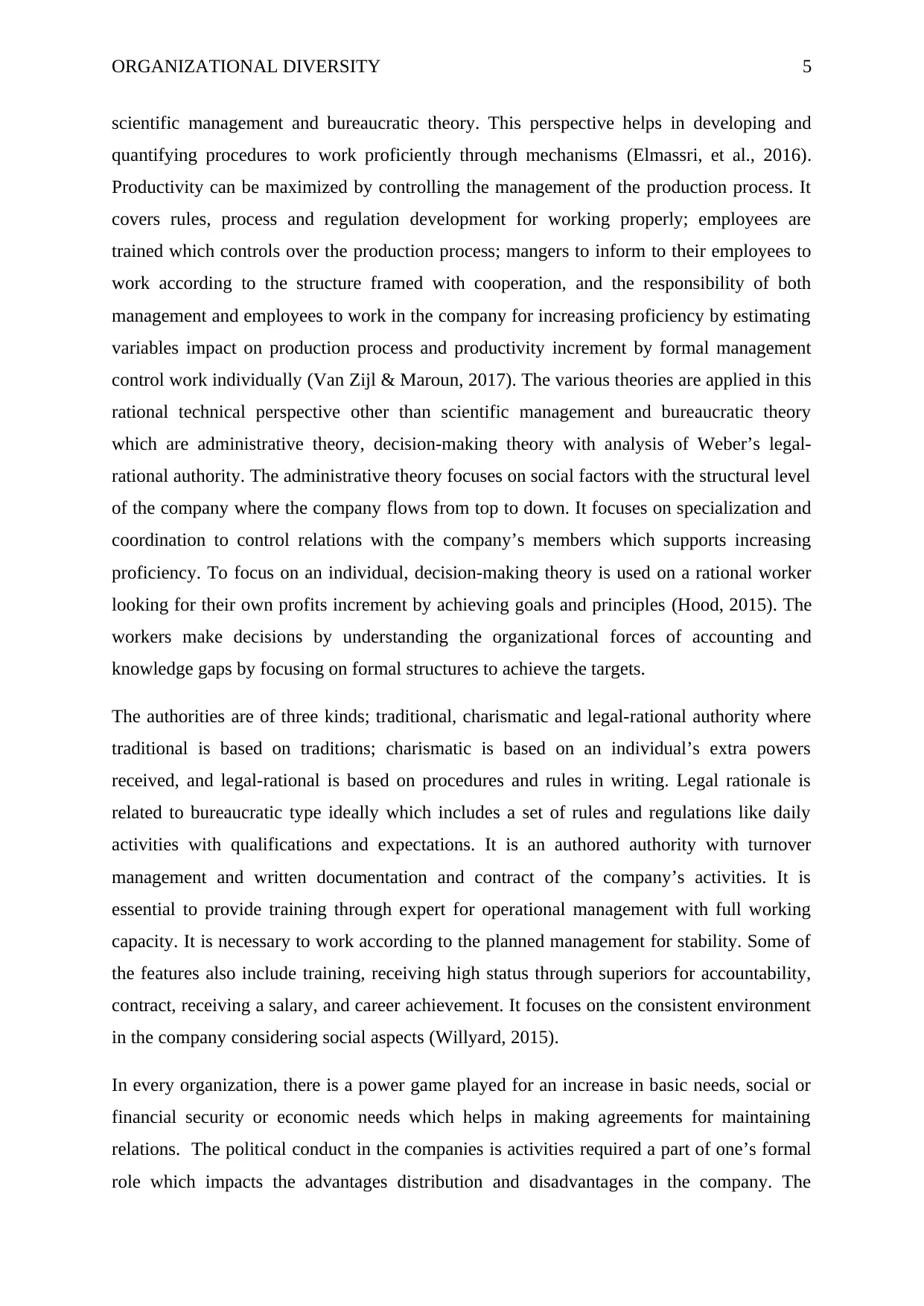
ORGANIZATIONAL DIVERSITY 5
scientific management and bureaucratic theory. This perspective helps in developing and
quantifying procedures to work proficiently through mechanisms (Elmassri, et al., 2016).
Productivity can be maximized by controlling the management of the production process. It
covers rules, process and regulation development for working properly; employees are
trained which controls over the production process; mangers to inform to their employees to
work according to the structure framed with cooperation, and the responsibility of both
management and employees to work in the company for increasing proficiency by estimating
variables impact on production process and productivity increment by formal management
control work individually (Van Zijl & Maroun, 2017). The various theories are applied in this
rational technical perspective other than scientific management and bureaucratic theory
which are administrative theory, decision-making theory with analysis of Weber’s legal-
rational authority. The administrative theory focuses on social factors with the structural level
of the company where the company flows from top to down. It focuses on specialization and
coordination to control relations with the company’s members which supports increasing
proficiency. To focus on an individual, decision-making theory is used on a rational worker
looking for their own profits increment by achieving goals and principles (Hood, 2015). The
workers make decisions by understanding the organizational forces of accounting and
knowledge gaps by focusing on formal structures to achieve the targets.
The authorities are of three kinds; traditional, charismatic and legal-rational authority where
traditional is based on traditions; charismatic is based on an individual’s extra powers
received, and legal-rational is based on procedures and rules in writing. Legal rationale is
related to bureaucratic type ideally which includes a set of rules and regulations like daily
activities with qualifications and expectations. It is an authored authority with turnover
management and written documentation and contract of the company’s activities. It is
essential to provide training through expert for operational management with full working
capacity. It is necessary to work according to the planned management for stability. Some of
the features also include training, receiving high status through superiors for accountability,
contract, receiving a salary, and career achievement. It focuses on the consistent environment
in the company considering social aspects (Willyard, 2015).
In every organization, there is a power game played for an increase in basic needs, social or
financial security or economic needs which helps in making agreements for maintaining
relations. The political conduct in the companies is activities required a part of one’s formal
role which impacts the advantages distribution and disadvantages in the company. The
scientific management and bureaucratic theory. This perspective helps in developing and
quantifying procedures to work proficiently through mechanisms (Elmassri, et al., 2016).
Productivity can be maximized by controlling the management of the production process. It
covers rules, process and regulation development for working properly; employees are
trained which controls over the production process; mangers to inform to their employees to
work according to the structure framed with cooperation, and the responsibility of both
management and employees to work in the company for increasing proficiency by estimating
variables impact on production process and productivity increment by formal management
control work individually (Van Zijl & Maroun, 2017). The various theories are applied in this
rational technical perspective other than scientific management and bureaucratic theory
which are administrative theory, decision-making theory with analysis of Weber’s legal-
rational authority. The administrative theory focuses on social factors with the structural level
of the company where the company flows from top to down. It focuses on specialization and
coordination to control relations with the company’s members which supports increasing
proficiency. To focus on an individual, decision-making theory is used on a rational worker
looking for their own profits increment by achieving goals and principles (Hood, 2015). The
workers make decisions by understanding the organizational forces of accounting and
knowledge gaps by focusing on formal structures to achieve the targets.
The authorities are of three kinds; traditional, charismatic and legal-rational authority where
traditional is based on traditions; charismatic is based on an individual’s extra powers
received, and legal-rational is based on procedures and rules in writing. Legal rationale is
related to bureaucratic type ideally which includes a set of rules and regulations like daily
activities with qualifications and expectations. It is an authored authority with turnover
management and written documentation and contract of the company’s activities. It is
essential to provide training through expert for operational management with full working
capacity. It is necessary to work according to the planned management for stability. Some of
the features also include training, receiving high status through superiors for accountability,
contract, receiving a salary, and career achievement. It focuses on the consistent environment
in the company considering social aspects (Willyard, 2015).
In every organization, there is a power game played for an increase in basic needs, social or
financial security or economic needs which helps in making agreements for maintaining
relations. The political conduct in the companies is activities required a part of one’s formal
role which impacts the advantages distribution and disadvantages in the company. The
⊘ This is a preview!⊘
Do you want full access?
Subscribe today to unlock all pages.

Trusted by 1+ million students worldwide
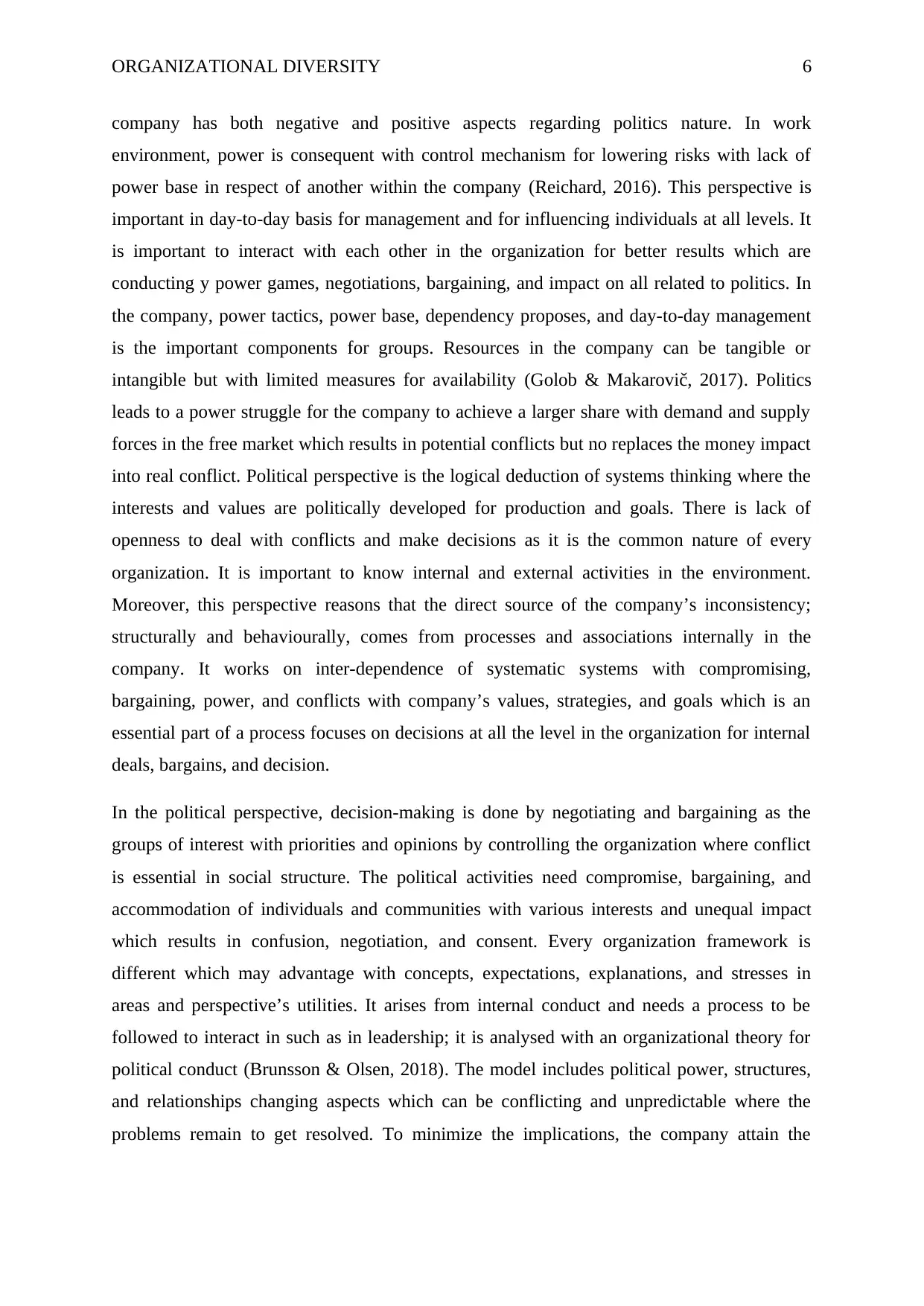
ORGANIZATIONAL DIVERSITY 6
company has both negative and positive aspects regarding politics nature. In work
environment, power is consequent with control mechanism for lowering risks with lack of
power base in respect of another within the company (Reichard, 2016). This perspective is
important in day-to-day basis for management and for influencing individuals at all levels. It
is important to interact with each other in the organization for better results which are
conducting y power games, negotiations, bargaining, and impact on all related to politics. In
the company, power tactics, power base, dependency proposes, and day-to-day management
is the important components for groups. Resources in the company can be tangible or
intangible but with limited measures for availability (Golob & Makarovič, 2017). Politics
leads to a power struggle for the company to achieve a larger share with demand and supply
forces in the free market which results in potential conflicts but no replaces the money impact
into real conflict. Political perspective is the logical deduction of systems thinking where the
interests and values are politically developed for production and goals. There is lack of
openness to deal with conflicts and make decisions as it is the common nature of every
organization. It is important to know internal and external activities in the environment.
Moreover, this perspective reasons that the direct source of the company’s inconsistency;
structurally and behaviourally, comes from processes and associations internally in the
company. It works on inter-dependence of systematic systems with compromising,
bargaining, power, and conflicts with company’s values, strategies, and goals which is an
essential part of a process focuses on decisions at all the level in the organization for internal
deals, bargains, and decision.
In the political perspective, decision-making is done by negotiating and bargaining as the
groups of interest with priorities and opinions by controlling the organization where conflict
is essential in social structure. The political activities need compromise, bargaining, and
accommodation of individuals and communities with various interests and unequal impact
which results in confusion, negotiation, and consent. Every organization framework is
different which may advantage with concepts, expectations, explanations, and stresses in
areas and perspective’s utilities. It arises from internal conduct and needs a process to be
followed to interact in such as in leadership; it is analysed with an organizational theory for
political conduct (Brunsson & Olsen, 2018). The model includes political power, structures,
and relationships changing aspects which can be conflicting and unpredictable where the
problems remain to get resolved. To minimize the implications, the company attain the
company has both negative and positive aspects regarding politics nature. In work
environment, power is consequent with control mechanism for lowering risks with lack of
power base in respect of another within the company (Reichard, 2016). This perspective is
important in day-to-day basis for management and for influencing individuals at all levels. It
is important to interact with each other in the organization for better results which are
conducting y power games, negotiations, bargaining, and impact on all related to politics. In
the company, power tactics, power base, dependency proposes, and day-to-day management
is the important components for groups. Resources in the company can be tangible or
intangible but with limited measures for availability (Golob & Makarovič, 2017). Politics
leads to a power struggle for the company to achieve a larger share with demand and supply
forces in the free market which results in potential conflicts but no replaces the money impact
into real conflict. Political perspective is the logical deduction of systems thinking where the
interests and values are politically developed for production and goals. There is lack of
openness to deal with conflicts and make decisions as it is the common nature of every
organization. It is important to know internal and external activities in the environment.
Moreover, this perspective reasons that the direct source of the company’s inconsistency;
structurally and behaviourally, comes from processes and associations internally in the
company. It works on inter-dependence of systematic systems with compromising,
bargaining, power, and conflicts with company’s values, strategies, and goals which is an
essential part of a process focuses on decisions at all the level in the organization for internal
deals, bargains, and decision.
In the political perspective, decision-making is done by negotiating and bargaining as the
groups of interest with priorities and opinions by controlling the organization where conflict
is essential in social structure. The political activities need compromise, bargaining, and
accommodation of individuals and communities with various interests and unequal impact
which results in confusion, negotiation, and consent. Every organization framework is
different which may advantage with concepts, expectations, explanations, and stresses in
areas and perspective’s utilities. It arises from internal conduct and needs a process to be
followed to interact in such as in leadership; it is analysed with an organizational theory for
political conduct (Brunsson & Olsen, 2018). The model includes political power, structures,
and relationships changing aspects which can be conflicting and unpredictable where the
problems remain to get resolved. To minimize the implications, the company attain the
Paraphrase This Document
Need a fresh take? Get an instant paraphrase of this document with our AI Paraphraser
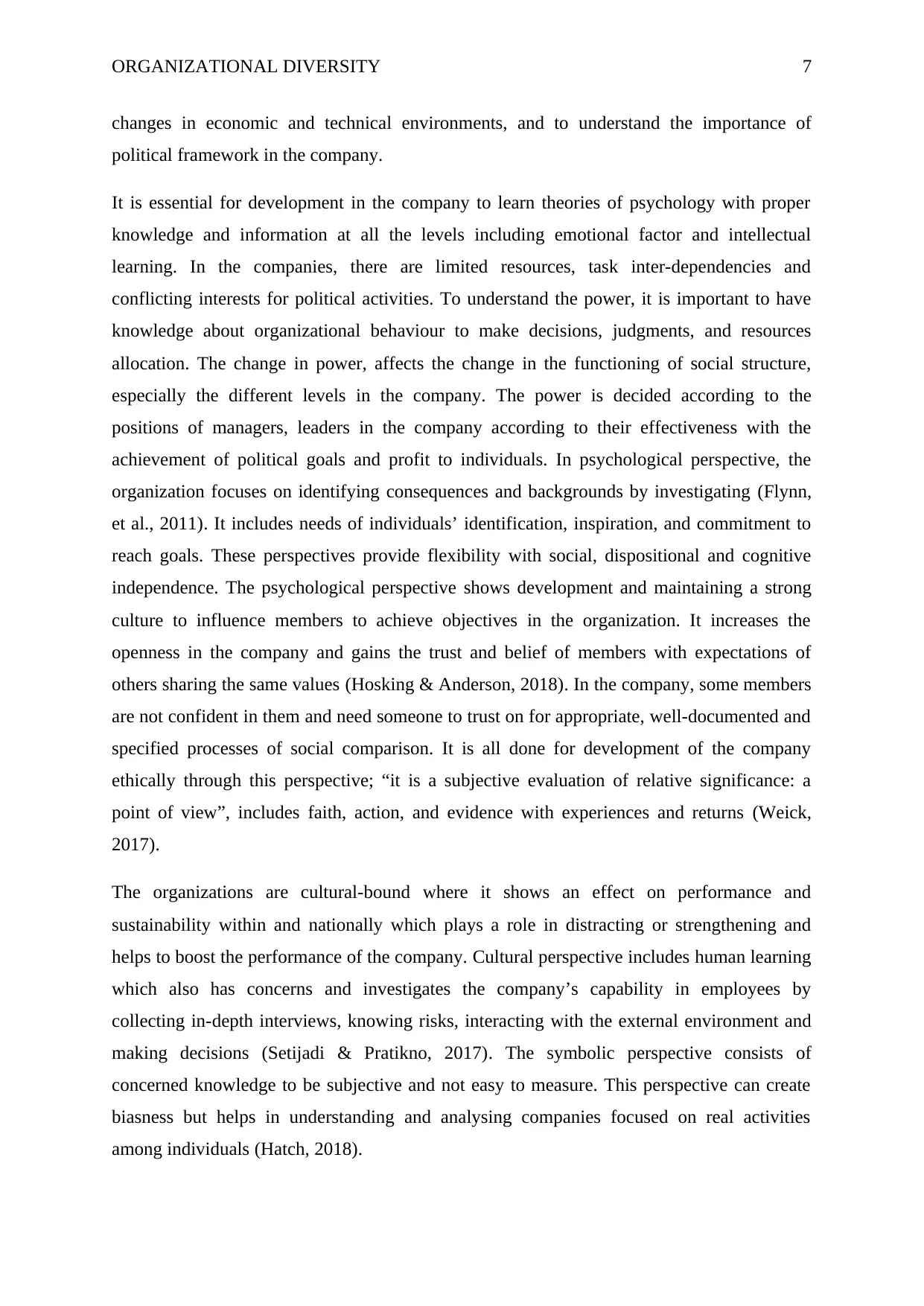
ORGANIZATIONAL DIVERSITY 7
changes in economic and technical environments, and to understand the importance of
political framework in the company.
It is essential for development in the company to learn theories of psychology with proper
knowledge and information at all the levels including emotional factor and intellectual
learning. In the companies, there are limited resources, task inter-dependencies and
conflicting interests for political activities. To understand the power, it is important to have
knowledge about organizational behaviour to make decisions, judgments, and resources
allocation. The change in power, affects the change in the functioning of social structure,
especially the different levels in the company. The power is decided according to the
positions of managers, leaders in the company according to their effectiveness with the
achievement of political goals and profit to individuals. In psychological perspective, the
organization focuses on identifying consequences and backgrounds by investigating (Flynn,
et al., 2011). It includes needs of individuals’ identification, inspiration, and commitment to
reach goals. These perspectives provide flexibility with social, dispositional and cognitive
independence. The psychological perspective shows development and maintaining a strong
culture to influence members to achieve objectives in the organization. It increases the
openness in the company and gains the trust and belief of members with expectations of
others sharing the same values (Hosking & Anderson, 2018). In the company, some members
are not confident in them and need someone to trust on for appropriate, well-documented and
specified processes of social comparison. It is all done for development of the company
ethically through this perspective; “it is a subjective evaluation of relative significance: a
point of view”, includes faith, action, and evidence with experiences and returns (Weick,
2017).
The organizations are cultural-bound where it shows an effect on performance and
sustainability within and nationally which plays a role in distracting or strengthening and
helps to boost the performance of the company. Cultural perspective includes human learning
which also has concerns and investigates the company’s capability in employees by
collecting in-depth interviews, knowing risks, interacting with the external environment and
making decisions (Setijadi & Pratikno, 2017). The symbolic perspective consists of
concerned knowledge to be subjective and not easy to measure. This perspective can create
biasness but helps in understanding and analysing companies focused on real activities
among individuals (Hatch, 2018).
changes in economic and technical environments, and to understand the importance of
political framework in the company.
It is essential for development in the company to learn theories of psychology with proper
knowledge and information at all the levels including emotional factor and intellectual
learning. In the companies, there are limited resources, task inter-dependencies and
conflicting interests for political activities. To understand the power, it is important to have
knowledge about organizational behaviour to make decisions, judgments, and resources
allocation. The change in power, affects the change in the functioning of social structure,
especially the different levels in the company. The power is decided according to the
positions of managers, leaders in the company according to their effectiveness with the
achievement of political goals and profit to individuals. In psychological perspective, the
organization focuses on identifying consequences and backgrounds by investigating (Flynn,
et al., 2011). It includes needs of individuals’ identification, inspiration, and commitment to
reach goals. These perspectives provide flexibility with social, dispositional and cognitive
independence. The psychological perspective shows development and maintaining a strong
culture to influence members to achieve objectives in the organization. It increases the
openness in the company and gains the trust and belief of members with expectations of
others sharing the same values (Hosking & Anderson, 2018). In the company, some members
are not confident in them and need someone to trust on for appropriate, well-documented and
specified processes of social comparison. It is all done for development of the company
ethically through this perspective; “it is a subjective evaluation of relative significance: a
point of view”, includes faith, action, and evidence with experiences and returns (Weick,
2017).
The organizations are cultural-bound where it shows an effect on performance and
sustainability within and nationally which plays a role in distracting or strengthening and
helps to boost the performance of the company. Cultural perspective includes human learning
which also has concerns and investigates the company’s capability in employees by
collecting in-depth interviews, knowing risks, interacting with the external environment and
making decisions (Setijadi & Pratikno, 2017). The symbolic perspective consists of
concerned knowledge to be subjective and not easy to measure. This perspective can create
biasness but helps in understanding and analysing companies focused on real activities
among individuals (Hatch, 2018).
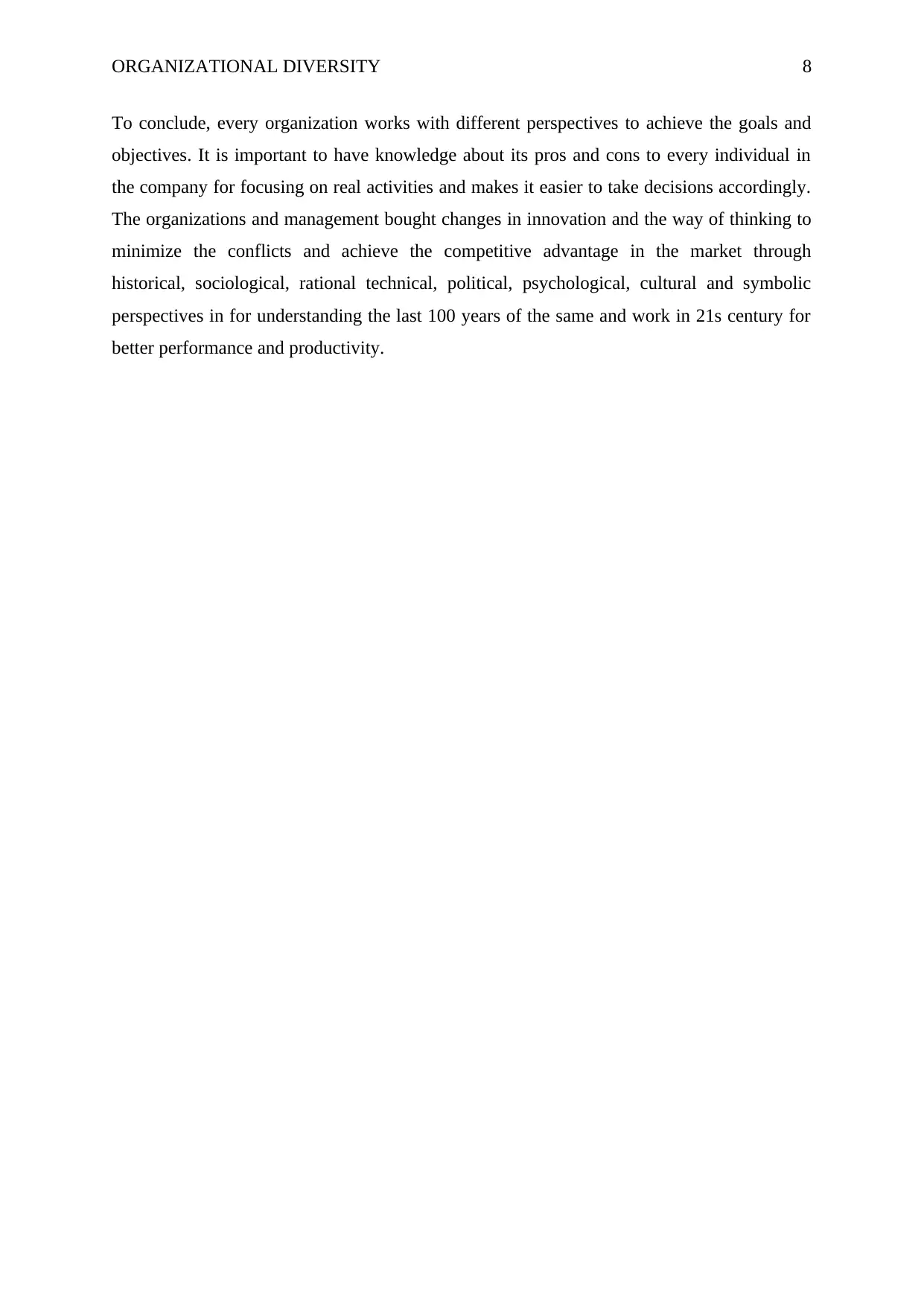
ORGANIZATIONAL DIVERSITY 8
To conclude, every organization works with different perspectives to achieve the goals and
objectives. It is important to have knowledge about its pros and cons to every individual in
the company for focusing on real activities and makes it easier to take decisions accordingly.
The organizations and management bought changes in innovation and the way of thinking to
minimize the conflicts and achieve the competitive advantage in the market through
historical, sociological, rational technical, political, psychological, cultural and symbolic
perspectives in for understanding the last 100 years of the same and work in 21s century for
better performance and productivity.
To conclude, every organization works with different perspectives to achieve the goals and
objectives. It is important to have knowledge about its pros and cons to every individual in
the company for focusing on real activities and makes it easier to take decisions accordingly.
The organizations and management bought changes in innovation and the way of thinking to
minimize the conflicts and achieve the competitive advantage in the market through
historical, sociological, rational technical, political, psychological, cultural and symbolic
perspectives in for understanding the last 100 years of the same and work in 21s century for
better performance and productivity.
⊘ This is a preview!⊘
Do you want full access?
Subscribe today to unlock all pages.

Trusted by 1+ million students worldwide
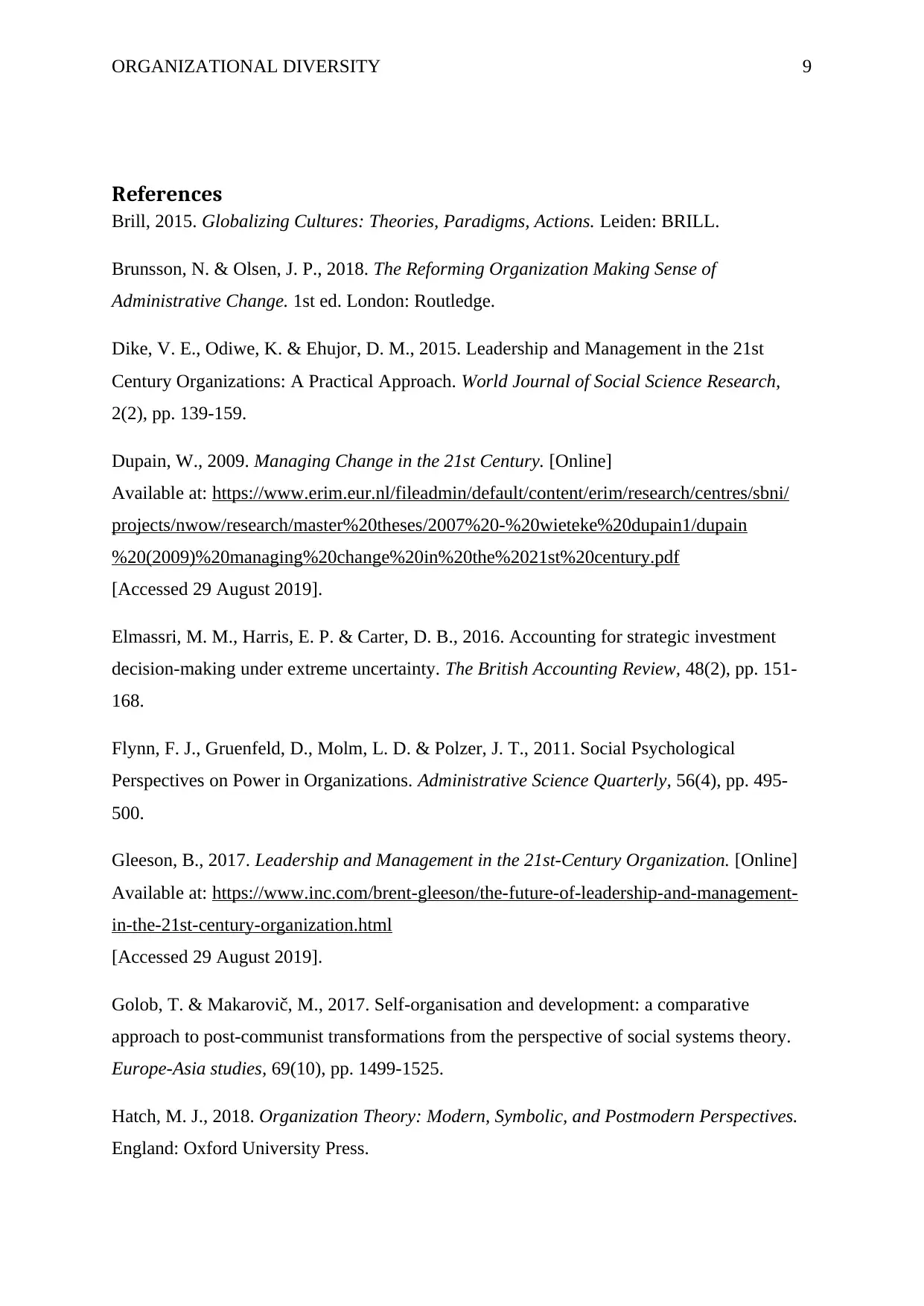
ORGANIZATIONAL DIVERSITY 9
References
Brill, 2015. Globalizing Cultures: Theories, Paradigms, Actions. Leiden: BRILL.
Brunsson, N. & Olsen, J. P., 2018. The Reforming Organization Making Sense of
Administrative Change. 1st ed. London: Routledge.
Dike, V. E., Odiwe, K. & Ehujor, D. M., 2015. Leadership and Management in the 21st
Century Organizations: A Practical Approach. World Journal of Social Science Research,
2(2), pp. 139-159.
Dupain, W., 2009. Managing Change in the 21st Century. [Online]
Available at: https://www.erim.eur.nl/fileadmin/default/content/erim/research/centres/sbni/
projects/nwow/research/master%20theses/2007%20-%20wieteke%20dupain1/dupain
%20(2009)%20managing%20change%20in%20the%2021st%20century.pdf
[Accessed 29 August 2019].
Elmassri, M. M., Harris, E. P. & Carter, D. B., 2016. Accounting for strategic investment
decision-making under extreme uncertainty. The British Accounting Review, 48(2), pp. 151-
168.
Flynn, F. J., Gruenfeld, D., Molm, L. D. & Polzer, J. T., 2011. Social Psychological
Perspectives on Power in Organizations. Administrative Science Quarterly, 56(4), pp. 495-
500.
Gleeson, B., 2017. Leadership and Management in the 21st-Century Organization. [Online]
Available at: https://www.inc.com/brent-gleeson/the-future-of-leadership-and-management-
in-the-21st-century-organization.html
[Accessed 29 August 2019].
Golob, T. & Makarovič, M., 2017. Self-organisation and development: a comparative
approach to post-communist transformations from the perspective of social systems theory.
Europe-Asia studies, 69(10), pp. 1499-1525.
Hatch, M. J., 2018. Organization Theory: Modern, Symbolic, and Postmodern Perspectives.
England: Oxford University Press.
References
Brill, 2015. Globalizing Cultures: Theories, Paradigms, Actions. Leiden: BRILL.
Brunsson, N. & Olsen, J. P., 2018. The Reforming Organization Making Sense of
Administrative Change. 1st ed. London: Routledge.
Dike, V. E., Odiwe, K. & Ehujor, D. M., 2015. Leadership and Management in the 21st
Century Organizations: A Practical Approach. World Journal of Social Science Research,
2(2), pp. 139-159.
Dupain, W., 2009. Managing Change in the 21st Century. [Online]
Available at: https://www.erim.eur.nl/fileadmin/default/content/erim/research/centres/sbni/
projects/nwow/research/master%20theses/2007%20-%20wieteke%20dupain1/dupain
%20(2009)%20managing%20change%20in%20the%2021st%20century.pdf
[Accessed 29 August 2019].
Elmassri, M. M., Harris, E. P. & Carter, D. B., 2016. Accounting for strategic investment
decision-making under extreme uncertainty. The British Accounting Review, 48(2), pp. 151-
168.
Flynn, F. J., Gruenfeld, D., Molm, L. D. & Polzer, J. T., 2011. Social Psychological
Perspectives on Power in Organizations. Administrative Science Quarterly, 56(4), pp. 495-
500.
Gleeson, B., 2017. Leadership and Management in the 21st-Century Organization. [Online]
Available at: https://www.inc.com/brent-gleeson/the-future-of-leadership-and-management-
in-the-21st-century-organization.html
[Accessed 29 August 2019].
Golob, T. & Makarovič, M., 2017. Self-organisation and development: a comparative
approach to post-communist transformations from the perspective of social systems theory.
Europe-Asia studies, 69(10), pp. 1499-1525.
Hatch, M. J., 2018. Organization Theory: Modern, Symbolic, and Postmodern Perspectives.
England: Oxford University Press.
Paraphrase This Document
Need a fresh take? Get an instant paraphrase of this document with our AI Paraphraser
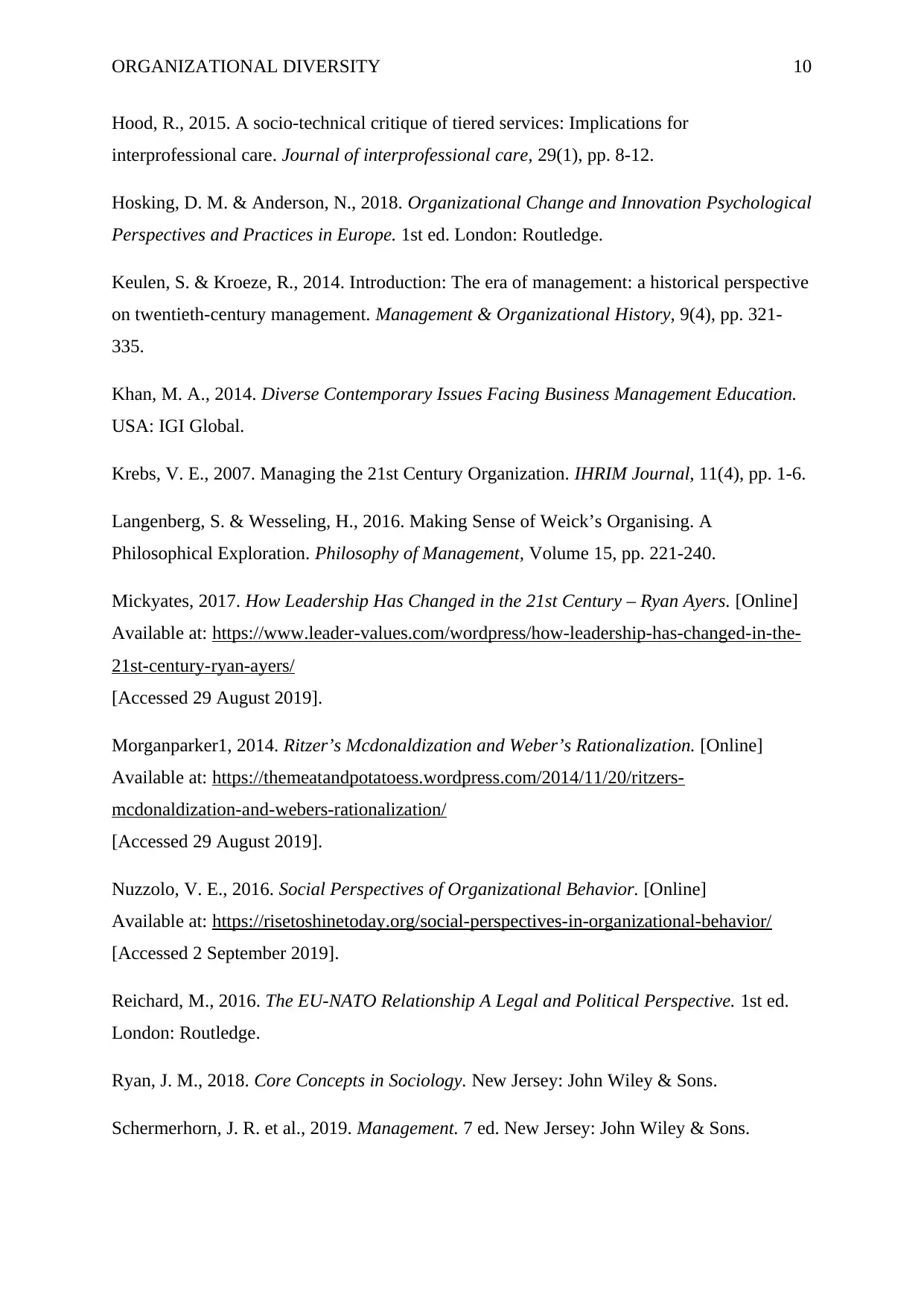
ORGANIZATIONAL DIVERSITY 10
Hood, R., 2015. A socio-technical critique of tiered services: Implications for
interprofessional care. Journal of interprofessional care, 29(1), pp. 8-12.
Hosking, D. M. & Anderson, N., 2018. Organizational Change and Innovation Psychological
Perspectives and Practices in Europe. 1st ed. London: Routledge.
Keulen, S. & Kroeze, R., 2014. Introduction: The era of management: a historical perspective
on twentieth-century management. Management & Organizational History, 9(4), pp. 321-
335.
Khan, M. A., 2014. Diverse Contemporary Issues Facing Business Management Education.
USA: IGI Global.
Krebs, V. E., 2007. Managing the 21st Century Organization. IHRIM Journal, 11(4), pp. 1-6.
Langenberg, S. & Wesseling, H., 2016. Making Sense of Weick’s Organising. A
Philosophical Exploration. Philosophy of Management, Volume 15, pp. 221-240.
Mickyates, 2017. How Leadership Has Changed in the 21st Century – Ryan Ayers. [Online]
Available at: https://www.leader-values.com/wordpress/how-leadership-has-changed-in-the-
21st-century-ryan-ayers/
[Accessed 29 August 2019].
Morganparker1, 2014. Ritzer’s Mcdonaldization and Weber’s Rationalization. [Online]
Available at: https://themeatandpotatoess.wordpress.com/2014/11/20/ritzers-
mcdonaldization-and-webers-rationalization/
[Accessed 29 August 2019].
Nuzzolo, V. E., 2016. Social Perspectives of Organizational Behavior. [Online]
Available at: https://risetoshinetoday.org/social-perspectives-in-organizational-behavior/
[Accessed 2 September 2019].
Reichard, M., 2016. The EU-NATO Relationship A Legal and Political Perspective. 1st ed.
London: Routledge.
Ryan, J. M., 2018. Core Concepts in Sociology. New Jersey: John Wiley & Sons.
Schermerhorn, J. R. et al., 2019. Management. 7 ed. New Jersey: John Wiley & Sons.
Hood, R., 2015. A socio-technical critique of tiered services: Implications for
interprofessional care. Journal of interprofessional care, 29(1), pp. 8-12.
Hosking, D. M. & Anderson, N., 2018. Organizational Change and Innovation Psychological
Perspectives and Practices in Europe. 1st ed. London: Routledge.
Keulen, S. & Kroeze, R., 2014. Introduction: The era of management: a historical perspective
on twentieth-century management. Management & Organizational History, 9(4), pp. 321-
335.
Khan, M. A., 2014. Diverse Contemporary Issues Facing Business Management Education.
USA: IGI Global.
Krebs, V. E., 2007. Managing the 21st Century Organization. IHRIM Journal, 11(4), pp. 1-6.
Langenberg, S. & Wesseling, H., 2016. Making Sense of Weick’s Organising. A
Philosophical Exploration. Philosophy of Management, Volume 15, pp. 221-240.
Mickyates, 2017. How Leadership Has Changed in the 21st Century – Ryan Ayers. [Online]
Available at: https://www.leader-values.com/wordpress/how-leadership-has-changed-in-the-
21st-century-ryan-ayers/
[Accessed 29 August 2019].
Morganparker1, 2014. Ritzer’s Mcdonaldization and Weber’s Rationalization. [Online]
Available at: https://themeatandpotatoess.wordpress.com/2014/11/20/ritzers-
mcdonaldization-and-webers-rationalization/
[Accessed 29 August 2019].
Nuzzolo, V. E., 2016. Social Perspectives of Organizational Behavior. [Online]
Available at: https://risetoshinetoday.org/social-perspectives-in-organizational-behavior/
[Accessed 2 September 2019].
Reichard, M., 2016. The EU-NATO Relationship A Legal and Political Perspective. 1st ed.
London: Routledge.
Ryan, J. M., 2018. Core Concepts in Sociology. New Jersey: John Wiley & Sons.
Schermerhorn, J. R. et al., 2019. Management. 7 ed. New Jersey: John Wiley & Sons.
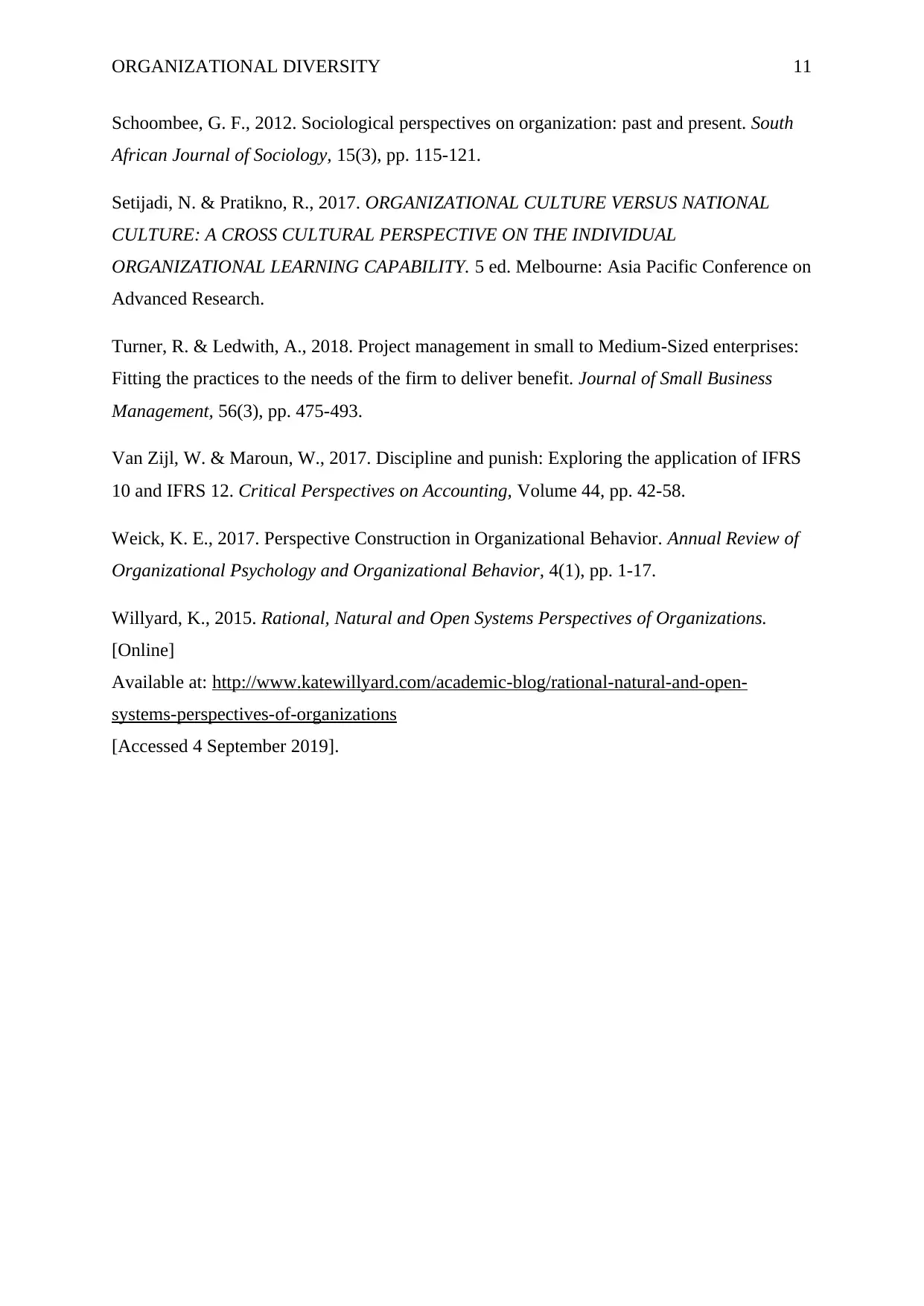
ORGANIZATIONAL DIVERSITY 11
Schoombee, G. F., 2012. Sociological perspectives on organization: past and present. South
African Journal of Sociology, 15(3), pp. 115-121.
Setijadi, N. & Pratikno, R., 2017. ORGANIZATIONAL CULTURE VERSUS NATIONAL
CULTURE: A CROSS CULTURAL PERSPECTIVE ON THE INDIVIDUAL
ORGANIZATIONAL LEARNING CAPABILITY. 5 ed. Melbourne: Asia Pacific Conference on
Advanced Research.
Turner, R. & Ledwith, A., 2018. Project management in small to Medium‐Sized enterprises:
Fitting the practices to the needs of the firm to deliver benefit. Journal of Small Business
Management, 56(3), pp. 475-493.
Van Zijl, W. & Maroun, W., 2017. Discipline and punish: Exploring the application of IFRS
10 and IFRS 12. Critical Perspectives on Accounting, Volume 44, pp. 42-58.
Weick, K. E., 2017. Perspective Construction in Organizational Behavior. Annual Review of
Organizational Psychology and Organizational Behavior, 4(1), pp. 1-17.
Willyard, K., 2015. Rational, Natural and Open Systems Perspectives of Organizations.
[Online]
Available at: http://www.katewillyard.com/academic-blog/rational-natural-and-open-
systems-perspectives-of-organizations
[Accessed 4 September 2019].
Schoombee, G. F., 2012. Sociological perspectives on organization: past and present. South
African Journal of Sociology, 15(3), pp. 115-121.
Setijadi, N. & Pratikno, R., 2017. ORGANIZATIONAL CULTURE VERSUS NATIONAL
CULTURE: A CROSS CULTURAL PERSPECTIVE ON THE INDIVIDUAL
ORGANIZATIONAL LEARNING CAPABILITY. 5 ed. Melbourne: Asia Pacific Conference on
Advanced Research.
Turner, R. & Ledwith, A., 2018. Project management in small to Medium‐Sized enterprises:
Fitting the practices to the needs of the firm to deliver benefit. Journal of Small Business
Management, 56(3), pp. 475-493.
Van Zijl, W. & Maroun, W., 2017. Discipline and punish: Exploring the application of IFRS
10 and IFRS 12. Critical Perspectives on Accounting, Volume 44, pp. 42-58.
Weick, K. E., 2017. Perspective Construction in Organizational Behavior. Annual Review of
Organizational Psychology and Organizational Behavior, 4(1), pp. 1-17.
Willyard, K., 2015. Rational, Natural and Open Systems Perspectives of Organizations.
[Online]
Available at: http://www.katewillyard.com/academic-blog/rational-natural-and-open-
systems-perspectives-of-organizations
[Accessed 4 September 2019].
⊘ This is a preview!⊘
Do you want full access?
Subscribe today to unlock all pages.

Trusted by 1+ million students worldwide
1 out of 12
Related Documents
Your All-in-One AI-Powered Toolkit for Academic Success.
+13062052269
info@desklib.com
Available 24*7 on WhatsApp / Email
![[object Object]](/_next/static/media/star-bottom.7253800d.svg)
Unlock your academic potential
Copyright © 2020–2025 A2Z Services. All Rights Reserved. Developed and managed by ZUCOL.




